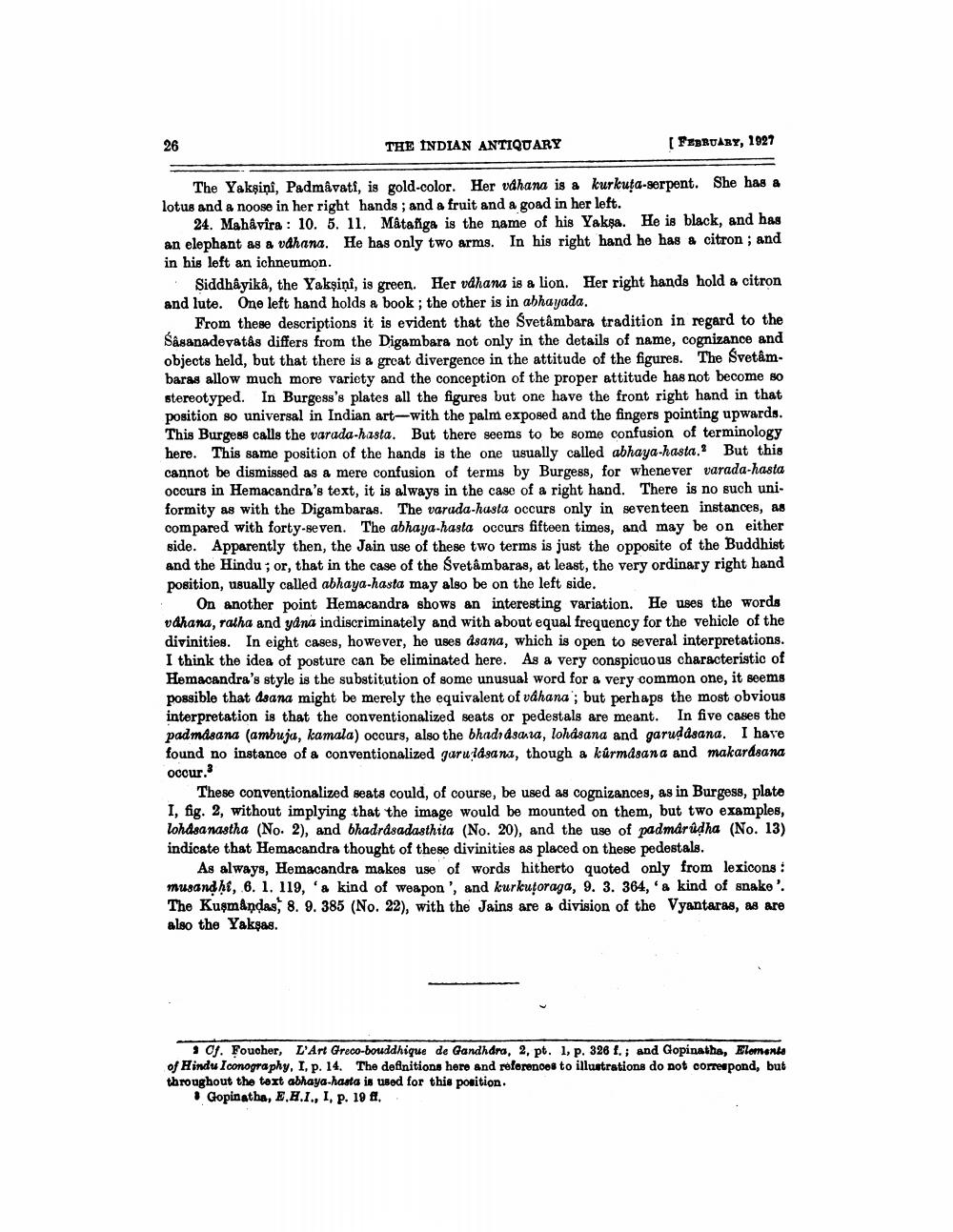________________
THE INDIAN ANTIQUARY
[ FEBRUARY, 1927
The Yakşini, Padmavati, is gold-color. Her vdhana is a kurkuta-serpent. She has a lotus and a noose in her right hands; and a fruit and a goad in her left.
24. Mahavira : 10. 5. 11. Mátañiga is the name of his Yakşa. He is black, and has an elephant as a vdhana. He has only two arms. In his right hand he has a citron; and in his left an ichneumon.
Siddhåyika, the Yakşini, is green. Her vdhana is a lion. Her right hands hold a citron and lute. One left hand holds a book; the other is in abhaijada.
From these descriptions it is evident that the Svetâmbara tradition in regard to the Sasanadevatas differs from the Digambara not only in the details of name, cognizance and objects held, but that there is a great divergence in the attitude of the figures. The Svetâmbaras allow much more variety and the conception of the proper attitude has not become so stereotyped. In Burgess's plates all the figures but one have the front right hand in that position so universal in Indian art-with the palm exposed and the fingers pointing upwards. This Burgess calls the varada-hasta. But there seems to be some confusion of terminology here. This same position of the hands is the one usually called abhaya-hasta. But this cannot be dismissed as a mere confusion of terms by Burgess, for whenever varada-hasta occurs in Hemacandra's text, it is always in the case of a right hand. There is no such uniformity as with the Digambaras. The varuda-hasta occurs only in seventeen instances, as compared with forty-seven. The abhaya-hasta occurs fifteen times, and may be on either side. Apparently then, the Jain use of these two terms is just the opposite of the Buddhist and the Hindu ; or, that in the case of the Svetâmbaras, at least, the very ordinary right hand position, usually called abhaya-hasta may also be on the left side.
On another point Hemacandra shows an interesting variation. He uses the words vdhana, ratha and yana indiscriminately and with about equal frequency for the vehicle of the divinities. In eight cases, however, he uses dsana, which is open to several interpretations. I think the idea of posture can be eliminated here. As a very conspicuous characteristic of Hemacandra's style is the substitution of some unusual word for a very common one, it seems possible that dsana might be merely the equivalent of vahana'; but perhaps the most obvious interpretation is that the conventionalized seats or pedestals are meant. In five cases the padmasana (ambuja, kamala) occurs, also the bhadrasara, lohdsana and garuddsana. I have found no instance of a conventionalized garu dagana, though a kúrmdsana and makardsana occur.
These conventionalized seats could, of course, be used as cognizances, as in Burgess, plate I, fig. 2, without implying that the image would be mounted on them, but two examples, lohdsa nastha (No. 2), and bhadrdsadasthita (No. 20), and the use of padmarudha (No. 13) indicate that Hemacandra thought of these divinities as placed on these pedestals.
As always, Hemacandra makes use of words hitherto quoted only from lexicons : musand hi, 6. 1. 119, 's kind of weapon', and kurkutoraga, 9. 3. 364, a kind of snake'. The Kuşmåndas, 8. 9.385 (No. 22), with the Jains are a division of the Vyantaras, as are also the Yakşas.
of. Foucher, L'Art Greco-bouddhique de Gandhdra, 2, pt. 1, p. 326 1.; and Gopinatha, Elemente of Hindu Iconography. I, p. 14. The definitions here and reforences to illustrations do not correspond, but throughout the text abhaya-hasta is used for this position.
Gopinatha, E.H.1., I. p. 19 f..




